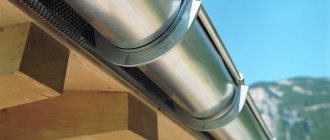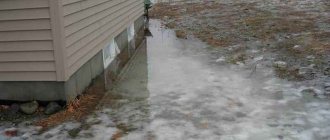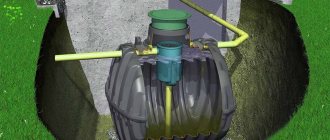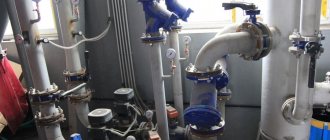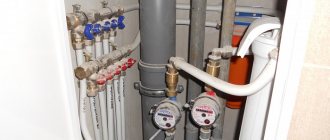- How to calculate pump power
- Internal sewerage
Sewage systems for a private home or summer cottage differ from urban ones in their autonomy. And while some country villages have central water supply, they do not have sewerage. Therefore, it is important to think through all the nuances of pipeline installation.
Water supply and sewerage of a private house - main stages
The first step in arranging a private home is choosing a source of drinking water supply. As a rule, there are two options - building a well and drilling a well. Once the choice of water supply source has been determined, we move on to design. Water supply and sewerage of a private house should be carried out in the following sequence:
- drilling a well (if the choice fell on an artesian well, there will be a need for a caisson);
- installation of automation and well pump;
- water supply to the house. Which pipes to choose for water supply depends, first of all, on the project budget, as well as operating conditions;
- installation of filters that will provide residents of the house with high quality drinking water;
- installation of a sewerage system;
- maintenance of engineering systems.
Water supply system design
When designing water supply systems, be sure to take into account the depth of the well, the volume of water used and other important factors. In addition, the water supply system must provide the necessary pressure, have reliable protection from the negative effects of the environment, and provide high-quality water purification from harmful impurities.
Do-it-yourself water supply installation is becoming more and more popular every year. A wide selection of tools and materials allows you to carry out work in the shortest possible time. You can build wells or drill wells. Wells are more popular due to the speed of creation and lower cost than the creation of concrete wells. Sandy wells are driven to the second aquifer, artesian wells to deep layers. To pump out water you will need submersible pumps. If the groundwater level is high, you can use surface pumps that are installed directly in the house. The installation of storage tanks will eliminate the risk of interruptions in the operation of systems such as water supply and sewerage of a private home.
Sewerage
The design of the drainage network consists of creating a system of trenches and depressions. They are equipped with receiving tanks and pipes connecting the outlet from the house to the containers. There are three main types of autonomous sewer networks:
- cesspool;
- septic tank;
- local treatment plant.
The first option is used only in houses with a small number of inhabitants. The complex is a receiving tank into which wastewater from the house flows. As the container fills, a sewer truck is called to pump out the liquid. The simplest, most accessible type of autonomous system, but requiring constant attention and control over the level of wastewater.
The septic tank is capable of partially recycling wastewater. The principle of its operation is to transfer clarified water from one section to another, during which organic matter settles to the bottom of the tank. Organic pumping is required much less frequently.
The local wastewater treatment plant (LTP) performs complete wastewater disposal. It works on the principle of a septic tank, but special bacteria are used to destroy organic matter. They absorb silt, freeing the water from all impurities.
The parameters of an autonomous sewer system depend on several factors:
- number of people;
- mode of use of the system (permanent residence or periodic cases);
- specific site conditions (soil type, configuration, groundwater level, etc.).
In addition, the financial condition of the home owner becomes a significant factor. Purchasing ready-made kits is expensive, so they often prefer to assemble drainage systems themselves.
Types of water supply systems
- Central water supply - in this case, the owner does not need to arrange a source of water supply to the home. It is enough for him to crash into the central water supply line, according to the accepted rules. However, this method has a number of disadvantages: dependence on central supplies, not very good water quality, high cost per cubic meter of liquid.
- Well - it can be constructed at a depth of 5-15 meters. A pumping station is installed in the well, which supplies water to the house.
- A sand well is an intermediate option between an artesian well and a well. In this case, when drilling, only the “sand horizon” is affected, that is, the top layer of soil.
- An artesian well is considered one of the most reliable and desirable sources of water for homes. If drilling and installation work is carried out using all technologies, then the well can last several decades. Moreover, it must be at least 135 meters deep
Centralized connection
If there is a centralized water supply in close proximity to the property, many people decide to use it. This method is simpler and cheaper to install. However, the calculation of the tariff often costs a pretty penny. But on the other hand, there is a saving in electrical energy, which is spent on ensuring the functioning of the pump. By the way, this side also has a second positive point. Even if there are power outages, the supply from the centralized system will not stop. After all, the resource is already being built under considerable pressure. But the pump, of course, will stop working.
But you need to immediately contact the organizing company and ask them for some data. First of all, we are interested in pressure. After all, it is not always really strong, sometimes it flows in a barely noticeable trickle.
The second point is the chemical composition. It may well contain substances harmful to health. Usually they are allowed for consumption according to the maximum standards, but you still don’t want to spoil your immunity. Especially if you live with children. The only reasonable solution is to choose an autonomous system.
If the central water supply still attracts your attention, then you should submit a request to the management company so that you are given permission to connect. And only then contact professionals to order the appropriate service.
Water supply scheme for a private house
If there is a source of input on the site of a private house, then you can equip it with the help of a pump. The submersible device will pump water into a special storage tank in the house with a capacity of up to 500 liters. The storage tank is separated by a membrane or relay, which allows you to adjust the fluid pressure in it. When the tank is filled to capacity, the water supply pump is turned off, and if the water is used, the pump pumps water into the tank again. According to the presented diagram, the water supply system consists of the following parts:
- Well or well.
- A pumping station allows you to draw water from a water supply source.
- Hydraulic accumulator - creates a certain pressure in the system.
- Special filters that purify and prepare water for use.
- Equipment for heating water.
- Collector system.
Experts advise installing water supply systems at home in spring or summer, when groundwater is not so high, the soil itself is easy to process, and digging is faster. Installing a hydraulic accumulator, which allows you to control the pump on and off, is optional. In this case, other pump control methods are used. The layout of the water supply can be varied - it all depends on the wishes of the owners who decided to make their home more comfortable.
Project responses from Energy Systems
As a result of water supply or sewerage design, you will receive answers to a number of practical questions, including:
- what materials, products and equipment are optimal in your case;
- what quantity and what kind of products need to be purchased for subsequent installation;
- how best to lay networks and install equipment so that the water supply or sewerage system is durable, reliable and functionally sound.
Well for water supply
The well is considered one of the most accessible and common sources of water for private homes. This method is preferred if the water is at a depth of 5-15 meters. Depth and productivity are the main criteria when constructing a well. The water in the source must be sufficient to meet the needs. If you have a well, you can provide your home with liquid in the amount of 500 liters per day.
The well should not be located close to above-ground buildings (at least 5 meters). And also to sources of possible pollution: sewers, toilets, landfills (at least 50 meters).
The procedure for performing actions when constructing a well:
- Determining the location of the well using ionomer frames.
- Selection of building materials: reinforced concrete rings, brick, stone, processed logs.
- Digging a well manually or using special equipment.
- Interior and exterior finishing works.
One of the advantages of supplying water to a private home using a well is that in the absence of electricity, water can be extracted from it manually using a rope and a bucket. In addition, the price for digging a well is much less than for installing a well, especially an artesian one.
A few more advantages of wells:
- Service life - about half a century;
- There is no need to collect a package of official papers to install a well on your country property;
- All work on cleaning and disinfecting the well is convenient to carry out, thanks to the large diameter of the rings;
- Availability of clean water, free of rust and chlorine.
Design of engineering systems for a country house - stages of work
A comprehensive engineering systems project contains several stages of work:
- At the first stage, a commercial proposal is developed, which serves as the basis for the development of technical specifications. The technical specifications reflect all the requirements and conditions of the cottage owner, and the final document of this stage is the feasibility study. The feasibility study links the Customer’s requirements with the cost indicators of design and installation work
- The second stage involves the creation of a preliminary design, in which the main characteristics are calculated, and the necessary equipment is selected. Also at this stage, all design decisions are coordinated with the construction part
- The stage of development of installation diagrams includes the development of design solutions for the installation of internal networks or equipment. An important feature of this stage is the coordination of equipment placement with communication routes
- At the final stage, a complete set of technical documentation is developed with the characteristics and specifications of the equipment, as well as specifications for the materials used
The cost of each stage is approved at the stage of creating a commercial proposal or approving the terms of reference for the project.
Technology for laying water supply and sewerage systems
For water supply, the thermal insulation of the pipeline is very important, therefore, the pipeline is either insulated to the required condition with polystyrene foam casings, stone wool, or buried to a level inaccessible to freezing. The water supply is laid using steel or plastic pipes; for sewerage, the latter option is most often used. The characteristics of foam propylene, PVC, polyethylene satisfy the conditions of strength, environmental friendliness, maintainability, and safety. The internal surfaces of the pipes are smooth, which makes it difficult to collect sewage and increases the overhaul period of the systems.
The laying of gravity sewer lines is made from products Ø150 mm, 110 mm, for water supply Ø32 mm is used. Pressure sewerage is created from 50 mm pipes, since stable pressure improves the self-cleaning ability of the flow. At the same time, the amount of excavation work is reduced, and cleaning of pipelines from inspection wells becomes more convenient.
Difficulties in designing drainage and supply
It cannot be said that there are a lot of special nuances in this aspect. But still, the location of the autonomous structure requires some calculations. This means that the total work increases in any case.
Plus, special attention should be paid to the following positions:
- The distance from the septic tank to the house is 5 m;
- The distance between the septic tank and the well is 50 m;
- The distance to the well from the building is 5 m.
We get some pretty decent requests. But sometimes a site has natural landscape obstacles that simply do not allow creating points for drilling and removal at will. For example, on one side there is an inconvenient slope, on the other side there is a cozy gazebo, and in the center there is hard ground. You will have to try very hard to arrange everything in strict accordance with the norms and requirements of the law.
Construction of external water supply communications
When drawing up the project, the relief and size of the site are taken into account, since there are SNiP standards for external water supply and sewerage that regulate the removal of constructed objects from housing, roadways, neighboring areas, reservoirs, rivers, and mature trees. External water supply and sewerage networks can be laid at the excavation stage, the basement stage, or upon completion of the box construction. However, it is better to lay sleeves for the sewer outlet and water supply inlet when pouring the foundation.
The water supply is installed from the well to the house at the depth of soil freezing. Additional thermal insulation will eliminate problems in cold, snowless winters.
Sewage pipes are laid from the house to the septic tank, maintaining a slope of 3 degrees, rounding 90˚ corners in two 45˚ sections, equipping each turn with an inspection well. Water from the well is pumped by a pump and moves through the sewer pipes by gravity. In some cases, forced sewerage is used (difficult terrain).
The water supply and sewage system of the house must be as repairable as possible, otherwise the amount of excavation work increases sharply, and maintenance of the systems becomes inconvenient. In the first case, a high-quality sand and gravel cushion (protection against heaving forces) and additional insulation (guarantee against freezing in case of seasonal operation) are sufficient. Sewerage requires prefabricated inspection wells. The tray is installed at the bottom of the pit, tied with pipes, leaving a hole in each of them or interrupting it in the well. A corrugated pipe made of HDPE or PPE is placed on it, cut to ground level, and equipped with a plastic, polymer-sand hatch with a decorative cover.
Methods for laying sewers
The traditional way of laying water supply and sewerage systems is to make foundation pits for structures, trenches for pipelines, and then assemble them on site. There are alternative ways:
- trenchless laying - sections of pipes depend on the size of the equipment, the layer of earth is raised, a pipeline is slipped under it, the soil is returned to its place, creating a gravity slope in this case is impossible (or extremely difficult)
- puncture – the technique is used under roads, is limited to a length of 60 m, and requires significant effort
- punching – used only for large pipe diameters (from 600 mm)
- directional drilling – used in densely populated areas
Laying water supply and sewerage systems using traditional methods is most suitable for individual developers. However, in winter, compact equipment using puncture technology is increasingly used. The method is suitable for personal plots; the main line is divided into straight sections of 12 meters in size, connected by pipes using this technology. After that, differential, inspection, and rotary wells are installed in critical places. The technology makes it possible to maintain a gravity slope, which guarantees a reduction in the cost of operating the sewerage system.
Features of arrangement of intra-house networks
Internal water supply and sewerage networks are pipelines and equipment installed inside the house.
The end point of the in-house sewer line is the place where the pipe exits the building. In turn, for the water supply system, the place where the pipeline enters the house becomes the starting point of the network. The internal plumbing system consists of:
- introducing a pipe into the house;
- starting water metering and dispensing installation;
- source of hot water (this can be a boiler or boiler);
- double pipeline for separate supply of cold and hot water;
- supplies to water intake points;
- water consumers are a kitchen sink, washbasins, toilet, bowl, washing machine and dishwasher.
In-house sewer networks include:
- pipes coming from water intake points;
- sewer riser to which pipes are connected;
- the place where the sewer line is removed from the house.
Why you can trust us with design
We employ only experienced, qualified employees. We have extensive design experience and are improving our skills, thanks to which we can successfully apply modern design methods when performing work, use the latest technical solutions and create functional, reliable and cost-effective communications.
If you are just thinking about the need to design engineering systems, then you should know that design is the first stage of installing engineering systems at any facility. It is very difficult to create a functional water supply system without preliminary design, so it is better to foresee all the subtleties and nuances before installation begins. From us you can also order an electrical project, a sewerage system project, a heating project, a ventilation project and an air conditioning system project for your facility.
You can pre-calculate the cost of the project using the automatic service calculator.
How to design water supply from a well
To create an autonomous water supply project, you need to have complete information about the correspondence of the flow rate of the source, the daily need for water at home, and pump performance.
Therefore, design begins with determining the depth of the aquifer, calculating the daily flow rate of the future water intake, minimum and peak water consumption.
Each device has its own water consumption rate
This is the initial data, after receiving which the optimal source location is selected.
At the same time, the location where the cesspool or septic tank will be built is determined, since the distance between the sewage tank and the drinking well (and other own and neighboring buildings and structures) is strictly regulated.
Which autonomous system to choose - with a well or a borehole?
A well is constructed when the water in it is suitable for drinking. This is obtained from a depth in the soil from 4 to 15 m.
When deciding to operate a well, it is very important to consider whether it can supply water to a family of four.
The average well stock is 200 liters. The disadvantage of water intake from a well is the high probability of groundwater getting into drinking water.
Another option to connect water is to drill and equip a well.
Whether it is better than the option with a well depends, first of all, on the characteristics of the soil in the local area. Another important factor is the depth of the aquifers and their productivity.
When thinking about what kind of water supply project to implement in a private house, in a number of cases they decide to take advantage of the benefits of a well water supply system:
- water flows into the home in any case, even if the equipment fails - you can collect water in containers or buckets suitable for it;
- service life - an equipped well is used for at least 50 years;
- affordable cost of construction, which in the case of a well is much more expensive.
As you can see, the decisive factor when choosing a water supply source is the size of the budget for water supply facilities.
The price of a well is influenced by: drilling method, type of structure, the possibility or impossibility of using productive equipment during drilling and other factors.
As a rule, a well is drilled using special equipment, and the trenches for the pipes are dug by the site owners or contractor employees.
Before you finally decide whether to choose a well or a well for country water supply, talk to your neighbors and local residents.
Try the waters of those who live nearby. If most of the homeowners in the area use a well, it is probably locally feasible, economical, and reasonably effective.
If you decide to build a well, you should know some drilling features. There are two types of wells - artesian or “limestone” and “sand”. The choice of design for arrangement is determined by the depth of the aquifer and its type.
Drilling a well “on sand” - features
When drilling a well “into sand”, they use the upper layers of the “sandy aquifer”, which lies under the loam that filters groundwater.
Such a well often goes 40-50 m deep. If during drilling they fall into the bed of an underground river, then it is enough to make the well no more than 15 m deep. In this case, the filters and pipes of the system do not become clogged with sand, since the soil layer has a pebble structure, and excavation is reduced.
The facility can be operated for 15 to 20 years. A standard well lasts 5-7 years. If we talk about a 15-meter depth, then it is easier to achieve it manually. With this kind of drilling - experimentally - the probability of hitting a good water carrier is higher.
The operation of special equipment is associated with serious costs, and this method of drilling, according to many experts, is less effective. After all, the machine drills only to a given depth, and getting into a good water carrier is more problematic.
Drilling a well “on limestone” - features
An artesian well is drilled to limestone rocks, which can lie at a depth of 130-140 m.
Artesian water obtained from a well is of better quality, and its supply is practically unlimited. Minimum – 1500 l.
There is no need to install special equipment for water intake, since the water enters under high pressure.
Under pressure, it breaks out to the surface of the well itself. The source can be operated for 50 years.
Among the disadvantages of a well as a key component of the water supply system of a country house, its high cost and the need for registration should be mentioned. Since the limestone aquifer is included in the state strategic reserve, the object must be registered.
Equipment and its cost
A water supply project for a private home involves the operation of special equipment that is installed in the living area and above the source.
Raw materials are supplied using household water supply stations. Thanks to them, the supply and pressure of water is uninterrupted. The pump is connected to a hydraulic accumulator, to which drainage systems are connected.
When the water in the house is turned on, when residents open the faucet in the kitchen or bathroom, the water pressure in the system decreases. The control relay is usually activated when a value of 2.2 bar is reached, turning on the pump, which begins to pump water again.
Water continues to flow into the system until the pressure reaches 3 bar. In this case, the relay is activated again and the pump is turned off.
When a pump is installed above the source, a caisson is used in which the well is connected to the water supply system.
- The price of the caisson is approximately 15 thousand rubles.
- The cost of the pump depends on its technical characteristics. On average it is 2-4 thousand rubles. It is not recommended to buy a pump in advance.
After all, the technical parameters of the source are precisely determined only after drilling, and it is better to purchase pumping equipment that meets them. This will allow you to choose the optimal type of product that can supply water uninterruptedly.
General scheme of water supply in a private house
Required elements of the system:
- Water source.
- A hydraulic accumulator that generates the required pressure and controls the operation of the pump.
- Water filters – purifying and preparing water. To choose the right equipment, you need to conduct an examination by sending a water sample for laboratory testing. Process water is supplied to the house separately. Since this water is not prepared from it and is not drunk, it does not need filtration.
- The pump forces soil water into the system.
- A water heater is used to provide hot water to a home.
Features of well arrangement
- The time is right . It is better to carry out installation work in the summer, at the end of spring or beginning of autumn, when it is warm outside and it is easier to identify a good water carrier in the ground.
In the warm season, the water does not rise, the soil is more pliable, and digging trenches is easier. Due to the fact that the hydraulic accumulator is very expensive, many homeowners do without it, replacing the device with homemade analogues for regulating the pump.
- Place for a water source. Quite often people decide to dig wells for home water supply. It is easier and cheaper to equip such a facility.
And as already mentioned, in case of unforeseen circumstances, water intake from the well is possible using buckets. But before digging begins, you should decide on the choice of location for the water intake point.
They search for something suitable for a well using proven folk methods, or with the help of modern devices.
The surest way is to visually observe the volume of dew and its presence at 4-5 am for six months. Based on a summary of such observations and a diagram, you can find out exactly where more moisture accumulates. It is in this place that the well should be built.
When choosing a water intake point, sanitary restrictions must also be taken into account. At a distance of 50 m from the well there should be no compost heaps, cesspools, sewage drains, toilets or other pollution.
It is better to dig a hole at some distance from the house so that the washing out of sand from the soil does not cause the foundation to move.
Having determined a place for a well shaft, you can order a water supply and sewerage project for a private house. It is better to contact an experienced contractor who has sufficient knowledge and skills.
Although design is relatively expensive - a project can cost 50 rubles per square meter of plan - it requires a professional approach.
Only specialists can give accurate guidelines in the arrangement of water supply, select equipment correctly, calculate estimates and design an up-to-date and complete system that can work efficiently for many years.
In the meantime, while the contractor is preparing a project for the external water supply of a private house, in the case of a well, you can start digging it.
- Construction of a well pit. A well shaft with reinforced concrete rings is one of the most common options for arranging water sources. For its construction, the corresponding site is first leveled.
Then a circle is drawn with a radius greater than that of the concrete ring by 10-20 cm. Digging a hole is carried out using a shovel. You should stop when the edge of the ring placed in the hole protrudes 10 cm from it.
Typically, the side of the element rises to a height of 0.9 m, and sometimes 1 m. Once the required depth is reached, the reinforced concrete ring is immersed in the pit. In this case, at least 3 connecting brackets are installed on the end part.
They continue to dig the hole until the depth again reaches the height of the ring. The soil placed in the container is lifted up. Having reached the desired depth, the first ring is lowered, fixing the second ring to its end with staples.
In the latter, a hole is made with a diameter 1.5 times greater than the diameter of the pipe used in the water supply system. The work continues until water begins to seep into the well shaft.
As a rule, water intensively flows into the well on a 6-8 concrete ring. It is better if there are at least 3 fontanelles. Having stopped digging and laying the rings, the sand and water are pumped out, and the soil is removed.
Then they go deeper another half a meter, keeping the pump on, as the water flows intensively. Having completed the excavation, the mine is left for a day to determine the water level. It is covered and fenced to avoid accidents.
- Completion of the well arrangement . After a day, the water level is checked, controlling the mark of 1-1.5 m. This value is optimal. The water is pumped out, small stones are placed at the bottom of the pit, then a layer of crushed stone 30-50 cm high. This creates a natural water filter. Each joint of the rings is sealed with a mortar of cement and sand. If the work is carried out correctly, the well shaft is filled with water to 1.5 rings.
- How is the connection made?. The arrangement of water supply involves the installation of equipment and drainage systems. A trench is dug from the water source to the building, passing below the depth at which the soil freezes.
A pipe made of any suitable material is placed in the trench. When choosing pipes, they are guided by the budget and the characteristics that need to be obtained from the water supply. A common choice is metal-plastic pipes, which are easy to install, quite flexible, durable and strong. Experts advise installing the pump in the utility room of the house.
- Branch laying . You need to insert the pipe leading from the well into the hole on the concrete ring, bend it and lower it to the water in the shaft. A mesh filter must be placed inside the outlet. Make sure that the bottom of the pipe rises from the bottom of the well shaft by 30-40 cm.
Having reached this mark, the water is pumped out again, then a pin is driven into the well bottom. The pipe is attached to a pin. In a reinforced concrete ring, the hole is covered with a cement solution, after which the trench is buried.
At a depth of 0.4 m and at a distance of 1.5 m from the concrete rings, a clay castle is built near a water source. Its standard thickness is half a meter. A clay castle allows you to protect the well from rain and groundwater entering the source.
- Equipment Tips . The water supply installation is selected based on the technical parameters of the well. The most popular units raise water to a height of 40 m and pump from a depth of about 9 m. If the source is remote from the house, it is better to buy a self-priming centrifugal pump with an external injector. This one pumps water from a depth of 45 m.
- Pump installation. In the place where the pumping station is supposed to be installed, a minimum winter temperature of 2 degrees is permissible. Before entering the pump, you need to install a check valve and install a coarse water filter. A fine filter is placed behind the unit.
Then a pressure gauge is connected to the equipment, which reacts to the pressure of a relay and other devices. A pipe is inserted into the collector, which distributes water to consumers. The final work involves laying the wiring inside the house - room by room.
Features of well construction
When choosing a water source, in this case the same restrictions as outlined above are taken into account. The main difference is that the well can be installed directly next to the house.
The cost of a water supply project for a private home is higher in this case. Drilling a well will cost approximately 2-3 thousand rubles per square meter.
The amount of payment is influenced by the remoteness of the site, the types of elements, pipes, equipment used, the presence of quicksand in the ground and other factors. To save money, some drill a well on their own.
- Self-drilling of a well . To drill a well, you will need a tripod, a core and a lift. The tripod is mounted above the intended water intake location.
First, a 1-1.5 m deepening is made using a pin drill, removing the outer soil layer. A casing pipe with teeth is placed into the resulting hole. A well is drilled for her until a good water carrier appears. Everything that penetrates it first can be passed through.
Having found a suitable layer, a zinc-coated water pipe with a filter installed at its end is placed in the casing pipe. The segments of elements are connected using a coupling, and the joint areas are well coated with sealant. Next, the casing pipe is removed.
- Installation of equipment . There are two installation methods - with equipment above a warm utility well or with the installation of a caisson. The second method is quite popular.
In this case, dig the pipe at a depth of 2.5 m so that the diameter is twice the diameter of the caisson. A concrete cushion is poured onto the bottom so that its thickness is at least 0.2 m. Such a cushion bears the load from the caisson.
The borehole pipe is cut so that it protrudes into the caisson by 0.5 m. At a depth of about 2 m, a trench is dug into which the water pipe is placed. Water will be transported through it to the home. A hydraulic accumulator is installed inside a warm room.
The pump is fixed inside the caisson, then connected to the drainage system. After installing the control unit and filters, the caisson is poured around the perimeter with a concrete solution approximately 0.4 m thick. When the concrete hardens, the remaining space is filled with a mixture of cement and sand, leaving approximately 0.5 m to the top, after which the soil is laid. All this provides high-quality protection for the caisson in case of frost.
- Distribution of water inside the building. When water is brought into the house, it becomes possible to distribute it indoors. An important stage of work is the installation of water heating equipment. The choice of devices of this type today is wide.
A good option might be a 2-circuit gas boiler. One outlet is used to heat water in the heating system, the second - for household needs. Cold water is supplied from the pump to the boiler. There is an outlet from the boiler with hot water connected to the collector.
The collector distributes the water resource throughout the building. The boiler can also be single-circuit. This is how water is heated only for domestic needs. Electric or gas boilers are used.
A storage water heater powered by electricity is often installed. Cottages sometimes have more than one instantaneous heater installed. After installing a water supply system in a private house, you need to arrange sewerage and drainage.




